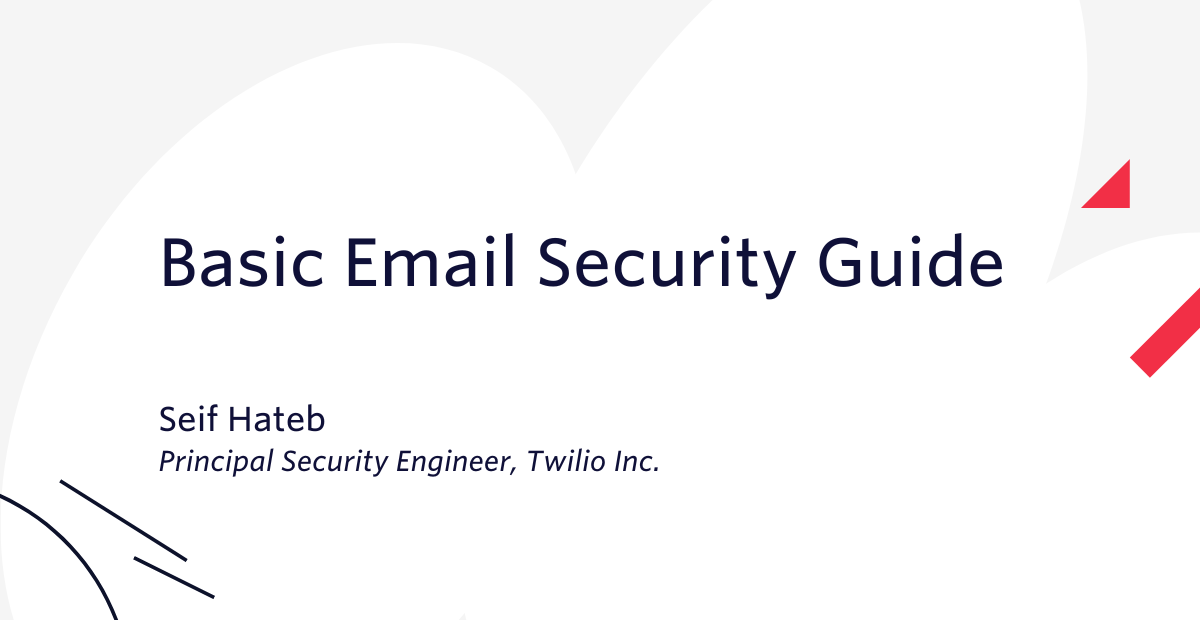Basic Email Security Guide
Time to read: 4 minutes

Email is one of the most used communication channels. Whether for internal or external collaboration, email is fast, simple, and reliable. However, despite its business criticality, it was not designed with security in mind.
That makes email security a must in order to protect its vital information flow. This involves various methods and procedures for protecting email accounts, content, and communications from unauthorized access, loss, or compromise.
In this post, we’ll discuss common email security risks, as well as our security recommendations so you can get the most out of it.
Common Email Security Risks
The design of email made it as accessible and open as possible to facilitate communication. However, its design has made it the number one attack vector and a popular tool for cybercriminals to conduct phishing campaigns, target users and organizations to trick them into disclosing sensitive information, or use as a vehicle to spread malware, spam, and misinformation campaigns. Exploiting email can even be an entry point to enterprise networks.
Emails can also be used to commit fraud and impersonate organizations and individuals, this might cause financial losses as well as reputational damage.
The most common email threats are:
- Malware: destructive payloads which can help gain a foothold into an organization's network.
- Spam: unwanted or junk emails that can cause security, reliability, and operations (increase cost) issues, even if they are benign in nature (due to potential high volumes).
- Phishing: emails that trick recipients into providing their credentials by luring them into fake websites and login pages, or emails that use social engineering techniques to gather sensitive information.
- Spear-Phishing: more sophisticated and targeted phishing attacks where emails are crafted specifically for a well defined target.
These malicious emails usually come in different formats: URL links, attachments, or even contained in the messages themselves.
Security Recommendations
So how do you address these email shortcomings? These sections will give an overview of the places you need to consider shoring up your email defenses and a short description of where to start or a useful link to a comprehensive guide.
Secure Configuration
Securely configure your email infrastructure per industry standards and control access to your relay servers to prevent abuse.
Email Authentication
Correctly configuring email authentication protocols is key to preventing unauthorized senders and domain abuse. This includes configuring SPF, DKIM, and DMARC – respectively, Sender Policy Framework, DomainKeys Identified Mail, and Domain-based Message Authentication, Reporting & Conformance.
These technologies are email authentication methods that validate that emails come from who they claim to be from and help your legitimate emails avoid the spam inbox by being authenticatable.
For more information, read the Twilio SendGrid Article about Email Authentication.
Email Encryption
Organizations frequently desire to safeguard the integrity and confidentiality of certain of their email communications. Cryptography – techniques that allow only senders and intended receivers access to message contents – may be used in a variety of ways to protect email communications. Below I’ve listed a few methods to employ cryptography to protect email:
- An email communication should be signed to ensure its authenticity and to verify the sender's identity.
- To protect the privacy of an email, encrypt the message's body.
- Note: If the receiver cannot match the required encryption level, the email will be dropped.
- To maintain the privacy of the message body and header, encrypt interactions between mail servers to ensure that the traffic is encrypted in transit.
Email Threat Protection
Most secure email gateways provide acceptable levels of threat protection that include content filtering for malware, scripts, unwanted file types, spam, size, rate, as well as bandwidth control. Providers also include anti-spoofing, anti-phishing, and encryption. The configuration of all these capabilities depends on your organization's security policy and business priorities.
Email Fraud Protection
Deploying email authentication can be complex, especially for large organizations. Fraud Protection platforms help you gain visibility by making the data you get from your DMARC reports easier to understand and actionable, combining your data with information collected from ISPs across the internet, and including a deep analysis of your existing configuration of SPF, DKIM, and DMARC.
Email Data Protection
Since email is the most used communication channel, it's also the channel where accidental and intentional data leaks happen most often. Creating custom policies to detect, alert, and prevent unauthorized data sharing is critical since out-of-the-box policies are rarely the best choice nor the most effective.
User Identity Protection
Malicious emails target companies' data and reputation, as well as users' identities that will give attackers access to the company networks. Enabling Multi-factor authentication for all users and monitoring accounts for abnormal behaviors and compromise help drastically reduce the risk of identity theft.
Threat Intelligence
To stay a step ahead, it's important to have enough information to be proactive and prevent security incidents from happening. Whether from the darknet, threat intelligence platforms, collaboration with industry verticals, or government institutions, your company needs to stay on top of evolving threats.
Good threat intelligence concentrates on how the intelligence information is made actionable. A good use case is monitoring fraudulent domains and stolen or leaked passwords and using this information to implement preventive security policies.
User Education and Awareness
Users are only humans; your users might be tricked into clicking on a link or downloading a file – even accidentally. Human fallibility is why education and awareness come into play: you need to keep your users aware and well-informed of common threats they might be exposed to and what needs to be done if they encounter those scenarios.
Conclusion
Technology facilitates our daily lives, but humans are the weakest point of the chain at the end of the day. A user and identity-centric approach remains the most efficient approach to securing email. This relies heavily on educating your users and making them aware of the risks and consequences.
Other Resources
Here are some resources to help understand the importance of email security and the best practices to enhance it:
- SMTP Security and Authentication
- Email Encryption Methods
- Recommendations and Guidelines for enhancing Trust in Email
- Understanding Business Email Compromise
Seif Hateb is a Security Professional working as a Principal Security Engineer at Twilio. With more than a decade of Security experience with success in guiding the design, testing, and implementation of leading-edge technologies and solutions while balancing security initiatives to risks, business operations, and innovations.
His specialties include Security Architecture, Cryptography, Data Protection, System Hardening and Security Assessment with extensive experience in the Telecommunications and Healthcare industries. Find him on LinkedIn and Twitter.
Related Posts
Related Resources
Twilio Docs
From APIs to SDKs to sample apps
API reference documentation, SDKs, helper libraries, quickstarts, and tutorials for your language and platform.
Resource Center
The latest ebooks, industry reports, and webinars
Learn from customer engagement experts to improve your own communication.
Ahoy
Twilio's developer community hub
Best practices, code samples, and inspiration to build communications and digital engagement experiences.

